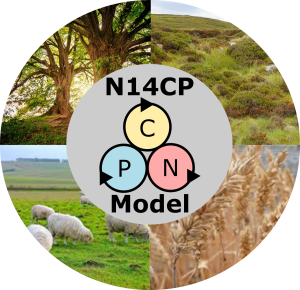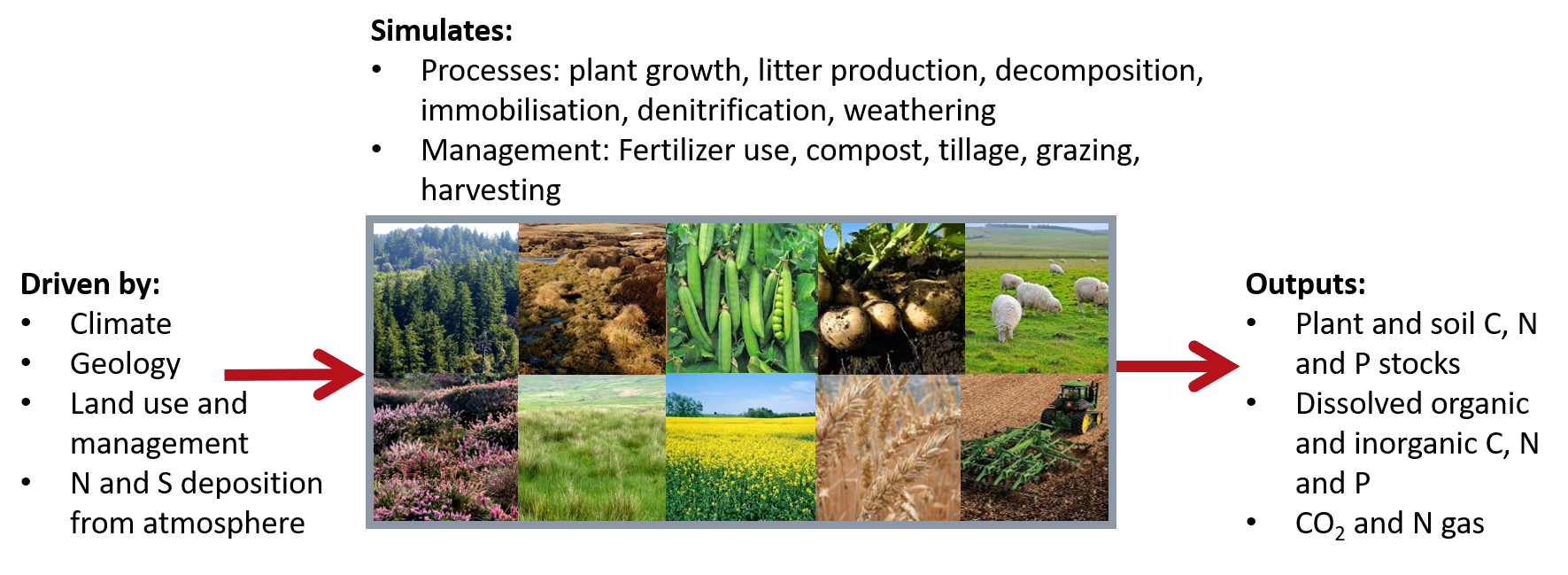
About the N14CP Model
The N14CP model is a process-based representation of carbon, nitrogen and phosphorus cycles in plants and soils. It simulates the interconnected movement of these nutrients from atmosphere to plants to soils and to waterways for a wide range of typical natural and agricultural ecosystems with mineral soils in boreal and temperate regions.
It is driven by climate data, nutrient inputs from human activities and from the atmosphere, geology, and land use and management.
It simulates processes such as plant growth, plant litter production, decomposition, immobilisation, denitrification, and weathering.
It produces estimates of:
- Plant and soil stocks of carbon, nitrogen and (organic and inorganic) phosphorus.
- Export of dissolved organic and inorganic carbon, nitrogen and phosphorus from land to waterways.
- Emissions of CO2 and nitrogen gases.

All models have different objectives, strengths and weaknesses. The N14CP model was developed to:
1.Integrate carbon, nitrogen and phosphorus cycles: as all three cycles have been extensively and intensively disturbed by human activities, such as inorganic fertilizer use in agriculture and atmospheric nitrogen pollution from fossil fuel burning. All three cycles are interlinked by biological processes, so it’s important we consider them together.
2. Explore the effects of land use change: including transitions between natural and agricultural land uses.
3. Simulate long term and large scale changes: N14CP Runs on quarterly timestep allowing long term simulation (decades/centuries), using readily available data at site to national/regional scales. It has also been developed using large data sets to be broadly applicable across sites, meaning it doesn’t require site-specific data for calibration.
All models have different limitations. For N14CP these include:
- Inter annual variability – the model is developed to simulate long timescales (10s to 100s of years) partly enabled by the quarterly timestep of the model. This however limits the ability of the model to capture inter-annual variability. This is less of an issue with soil carbon stores, but can limit accuracy of yield estimates and leaching as this is strongly influenced by hydrology and events at much finer timescales that the model does not capture.
- Speciation of gas emissions – currently total C and N loss in gas form is estimated, but not speciated.
- CO2 and light limitation not considered – the model does not currently take these into account as it is assumed most ecosystems in the regions of study are nutrient or climate limited.
- Mixed land cover – the model does not implement mixed land cover types such as those for silvo-arable and silvo-pastoral practices and, more broadly, agroforestry.
The N14CP model has been developed and extensively tested using data from:
- Plant, soil and leachate carbon, nitrogen and phosphorus.
- Multiple sites across European temperate/boreal regions.
- Long-term field experiments in both natural and agricultural contexts
- UK-wide soil survey data.
- Large compilations of plant biomass data across the UK.
- In-river concentrations of dissolved organic carbon, and dissolved inorganic and organic forms of nitrogen and phosphorus.
The model has been used to simulate specific sites (i.e. plot to field scale) across Northern Europe and applied at a national scale for the UK.
You can find out more about the model and it’s past applications in our publications, most of which are open access.
Model description:
- Janes-Bassett, V., Davies, J., Rowe, E.C. and Tipping, E., 2020. Simulating long-term carbon nitrogen and phosphorus biogeochemical cycling in agricultural environments. Science of the Total Environment, 714, p.136599.
- Davies, J.A.C., Tipping, E., Rowe, E.C., Boyle, J.F., Graf Pannatier, E. and Martinsen, V., 2016. Long‐term P weathering and recent N deposition control contemporary plant‐soil C, N, and P. Global Biogeochemical Cycles, 30(2), pp.231-249.
Applications:
- Yumashev, D., Janes-Bassett, V., Redhead, J.W., Rowe, E.C., and Davies, J., 2022. Terrestrial carbon sequestration under future climate nutrient and land use change and management scenarios: a national-scale UK case study. Environmental Research Letters, 17, p.114054.
- Janes-Bassett, V., Bassett, R., Rowe, E.C., Tipping, E., Yumashev, D. and Davies, J., 2021. Changes in carbon storage since the pre-industrial era: A national scale analysis. Anthropocene, 34, p.100289.
- Taylor, C.R., Janes-Bassett, V., Phoenix, G.K., Keane, B., Hartley, I.P. and Davies, J.A., 2021. Organic phosphorus cycling may control grassland responses to nitrogen deposition: a long-term field manipulation and modelling study. Biogeosciences, 18(13), pp.4021-4037.
- Tipping, E., Davies, J.A., Henrys, P.A., Jarvis, S.G. and Smart, S.M., 2021. Long-term effects of atmospheric deposition on British plant species richness. Environmental Pollution, 281, p.117017.
- Bell, V.A., Naden, P.S., Tipping, E., Davies, H.N., Carnell, E., Davies, J.A.C., Dore, A.J., Dragosits, U., Lapworth, D.J., Muhammed, S.E. and Quinton, J.N., 2021. Long term simulations of macronutrients (C, N and P) in UK freshwaters. Science of the Total Environment, 776, p.145813.
- Janes-Bassett, V., Bassett, R., Yumashev, D., Blair, G. and Davies, J., 2021. Mapping regional impacts of agricultural expansion on terrestrial carbon storage. Regional Studies, Regional Science, 8(1), pp.336-340.
- Tipping, E., Davies, J.A., Henrys, P.A., Jarvis, S.G., Rowe, E.C., Smart, S.M., Le Duc, M.G., Marrs, R.H. and Pakeman, R.J., 2019. Measured estimates of semi-natural terrestrial NPP in Great Britain: comparison with modelled values, and dependence on atmospheric nitrogen deposition. Biogeochemistry, 144(2), pp.215-227.
- Tipping, E., Davies, J.A.C., Henrys, P.A., Kirk, G.J., Lilly, A., Dragosits, U., Carnell, E.J., Dore, A.J., Sutton, M.A. and Tomlinson, S.J., 2017. Long-term increases in soil carbon due to ecosystem fertilization by atmospheric nitrogen deposition demonstrated by regional-scale modelling and observations. Scientific reports, 7(1), pp.1-11.
- Davies, J.A.C., Tipping, E. and Whitmore, A.P., 2016. 150 years of macronutrient change in unfertilized UK ecosystems: Observations vs simulations. Science of the Total Environment, 572, pp.1485-1495.
The original creator of the model, Prof. Ed Tipping, named it. The reasoning behind the name is:
a) It does what it says on the tin: it simulates carbon (C), nitrogen (N) and phosphorus (P) cycles as well as radiocarbon (14C). Including radiocarbon gives us a useful opportunity to test the turnover rates of soil using radiocarbon data. Bomb carbon from nuclear weapons testing in the 1950s and 60s created a pulse of 14C in the atmosphere that has been absorbed by plants during photosynthesis and incorporated into soils along with the plant matter. Measuring 14C in soils and using it in models can help us estimate the speed at which organic matter in soils decompose, which is important for carbon storage and ecosystem productivity. Read more about the bomb pulse.
b) It’s mildly amusing to chemists. Nitrogen has an atomic mass of 14 (N-14) and radiocarbon is 14C – hence N14C.
Contact
To find out more about the model, please get in touch: jess.davies@lancaster.ac.uk